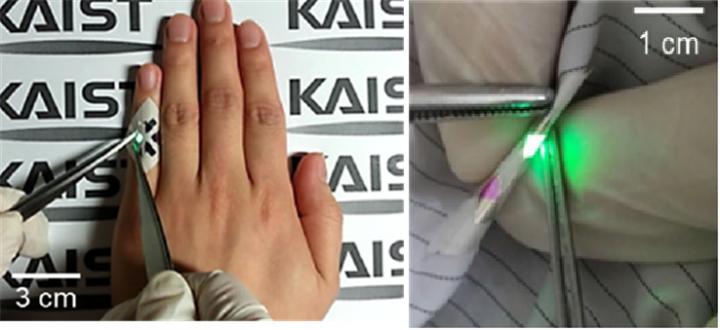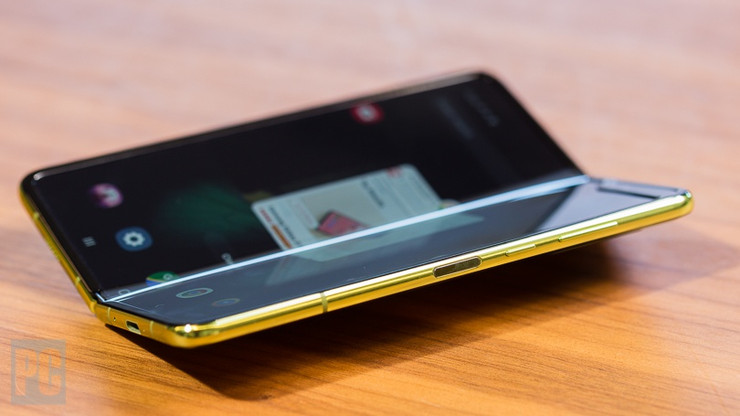If you have paid any attention to developments in the smartphone domain, you have no doubt heard talk of the Samsung Galaxy Fold and Huawei Mate X, both making headlines for their innovative foldable screen displays utilizing flexible OLEDs. On our blog, we have previously written about OLED technology generally, as well as wearable photonic devices in particular, but mainstream flexible electronics have appeared somewhat out of reach until this past year. While the flexible Galaxy Fold screen has been experiencing widely-publicized growing pains, there will no doubt be many smartphones utilizing such technology in the near future. So, how exactly do flexible OLED displays work, and are they simply a passing fad, or a truly revolutionary step forward for smartphones, and perhaps other mediums of display technology?
Flexible OLEDs: The Basics
The migration from inorganic to organic light emitting diodes (OLEDs) has been underway for many years now, but one of the most apparent advantages of organic semiconductors – the potential for flexible electronics – has only just begun to reach the wider market. The premise of flexible OLEDs is simple: instead of using an inorganic semiconductor on a rigid substrate to emit light, an organic material (such as a phosphorescent dye or conductive polymer) is instead fabricated on a flexible plastic substrate using inkjet or screen printing.
While inorganic LEDs require lattice-matching between two crystalline semiconductor materials, organic materials in OLED displays transport charge through conjugated molecular orbitals, which allows an intrinsic degree of flexibility. Additionally, since organic molecules comprising such organic semiconductors consist almost entirely of carbon and hydrogen atoms in a relatively amorphous structure, the weight of organic semiconductors is relatively light relative to their inorganic counterparts.
Advantages and Disadvantages
The underlying physics of OLEDs lend themselves to numerous inherent benefits: OLED displays are brighter, lighter, often more efficient, and as per the title of this article, afford flexibility to the electronic devices they are integrated into. Furthermore, while manufacturing OLED displays is still relatively expensive relative to LCD displays, scalable and affordable manufacturing techniques are being developed at a rapid pace. This has been reflected by the growth of the OLED industry, which in the past few years has risen in value by billions of dollars, with cellphones making up 81% of the total share. But what about flexible OLED displays in particular? Does this novel technology have a place in our everyday lives, or will it simply be relegated to more niche applications?
The foremost reason for the hype surrounding the recent unveiling of foldable smartphones is the newfound ability to have a device carrying a screen larger than the device itself when folded, for only a small sacrifice in thickness. Additionally, when the technology has further matured, such flexibility can extend to wearable electronics or even clothing. There are also inherent benefits to using flexible OLED technology besides the obvious potentiality of foldable or rollable devices. An electronic device that is able to flex, while not necessarily designed as its foremost feature, is durable and resistant to detrimental stresses in ways that current inorganic and brittle displays are not.
However, there is always the lingering problem of any flexible electronic device – residual stresses caused by continuous deformation (think of the opaque creases you see when bending plastic packaging over and over). These residual stresses may manifest as a simple crease mark on well-designed flexible OLED screens, but it also may result in downgraded performance in brightness or power efficiency. Another potential roadblock of flexible OLEDs is their much higher sensitivity to moisture impeding conduction. Furthermore, although it is relatively easy to fabricate flexible organic LEDs as well as deposit them on a flexible substrate, the search to find similarly flexible electrodes has lagged somewhat behind. Typical electrodes in LEDs, such as indium tin oxide (ITO) are brittle and can easily fracture, even as the displays are able to flex to a high degree.

Flexible OLEDs implanted into fabrics, courtesy of KAIST
The Future of Flexible Displays
While we have already seen the first generation of flexible OLED screens hit the market in the form of the Galaxy Fold and Huawei Mate X, there is still quite a ways to go before we see the technology fully perfected. There are high hopes for flexible electronics beyond the domain of gadgets – one day, you might begin to see organic LEDs in the seams of your clothing – but there are limitations inherent to the materials, as well as the costs associated with manufacture which will serve as a difficult roadblock to get over. While some of these hurdles might be answered by the ingenuity of designers and engineers, it is difficult to determine the extent to which flexible OLED screens will revolutionize our devices. There are certainly niches where flexible electronics feel right at home, such as smartwatches or curved television screens, but it is yet to be seen whether the new paradigm of foldable smartphones is a turning point or a passing fad.
Be sure to look at FindLight’s diverse selection of LEDs on our website, as well as other photonics-related articles on our blog.

